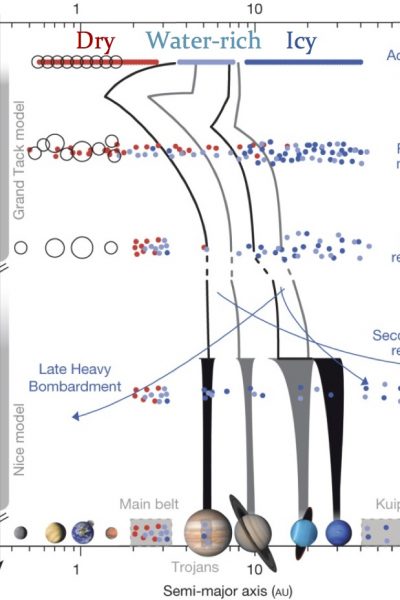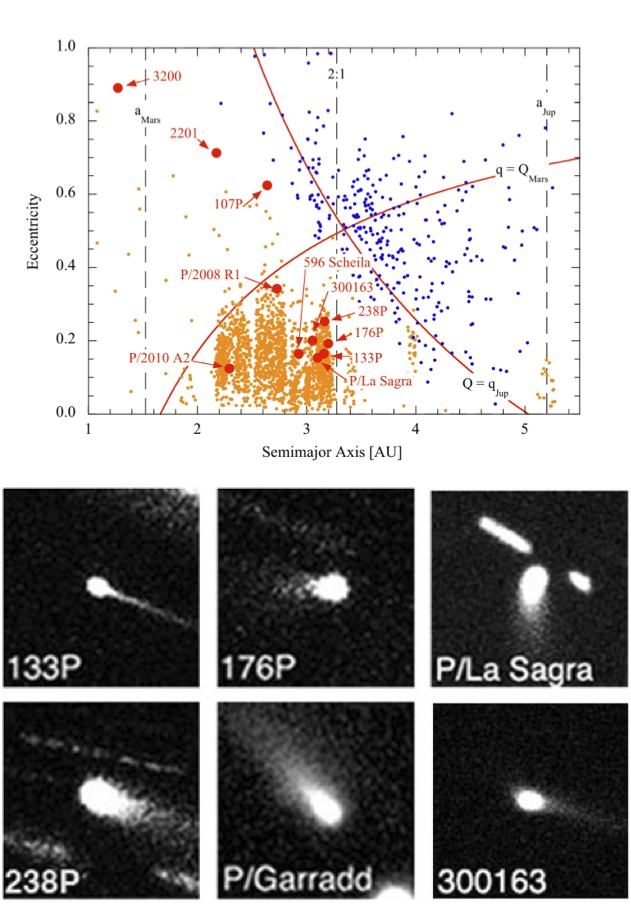Proposals submitted to the HSC survey from the HSC solar system science WG
- Search for source region of NEAs in the main asteroid belt
- Investigation of the TNO dynamical classes
- Search for the evidence of giant planet migration
- Search for the new Binary KBOs
- Search for “Planet X”, eccentric large TNOs, inner-Oort cloud objects
- Investigation on the origin of meteorites
- Investigation on characteristic of fast rotators
- Study of asteroid fragmentation processes
- Search for the origin of Jupiter Family Comets
- Search for Main Belt Comets
- Determination of asteroid’s density
Our aim is to detect small solar system bodies in the HSC SSP data to try and understand the early stages of the solar system’s history.
Why small solar system bodies?
Because the composition of the small solar system bodies (SSSBs) tells us about the materials present in the materials in early solar system. Most of the SSSBs are un-differentiated planetesimals; leftover building blocks from the epoch of planet formation. SSSB€™s composition reorbital distribution of SSSBs provides an important information about the migration of the giant planets (Jupiter,Saturn, Uranus,and Neptune). SSSBs have been gravitationally affected by the solar system’s giant planets; they have been scattered, transported, perturbed. Such actions from the planets can remain on the orbital/size/compositional distributions of SSSBs enabling astronomers to study the dynamical history of the giant planets. Therefore the investigation into the nature of the SSSBs leads us to a window into the early solar system.
The latest model of solar system formation
The latest model of solar system formation; combined the Grand tack and Nice model, tells us that the planet migration is a very important key in the history of the solar system, which caused large scale mass removal twice: earlier than 0.6 Myr and around 800-900 Myr.
Grand tack
In the solar nebula, the formation of planetesimals and proto-planets started. Jupiter was formed just beyond the snow line at that time, which is ~3.5 AU, then moved inward till Jupiter and Saturn were locked in the 3:2 mean motion resonance (MMR). Then Jupiter changed direction moving outward till ~5 AU due to the interaction with the gas disk. This process created the first mass removal, pushing inner planetesimals inward toward the Sun. It probably promoted the formation of terrestrial planets. Water-rich and ice objects formed beyond proto-Jupiter migrated into current region of main asteroid belt.

Figure: Latest model of the planet formation in the early stage of our solar system from F.E. DeMeo & B. Carry Nature 505, 629-634 (2014). It shows that different kinds of planetesimals formed in the proto-planetary disk at different distances from the Sun had been mixed up by planet migrations, and resulted in the current orbital distribution of small solar system bodies with mixed compositions in the main belt and the Kuiper belt.
Nice model
The Nice model is the second removal event.Many planetesimals still remained around the orbits of the giant planets after the Grand Tack scenario. By the gravitational interaction between planet and planetesimal, the radial motion of planets did not stop completely yet. About 800 Myr after the Grand Tack event, Jupiter and Saturn crossed the 1:2 MMR, a catastrophic disturbance happened, especially in the outer planets region. Jupiter moved inward, but Saturn, Uranus, and Neptune was kicked away to outer orbit, then emplacing planetesimals into the region know today as the Kuiper belt or trans-Neptunian region. This instability also caused the late heavy bombardment. At this point, a large number of planetesimals were also scattered into the terrestrial planet region, hitting the surfaces of the forming terrestial planets. This process provided probably additional water to the Earth.
The latest solar system formation model is still a hypothesis. We need to investigate whether the scenario is correct or not by observation. However, these models are able to reproduce some of the features of the Solar system. The Grand Tack model may be able to explain the low mass of Mars and variety of the main belt asteroids, dry, water-rich, even icy objects exist there. The Nice model can explain the complicated dynamical structure of current Trans-Neptunian Object (TNO) population, the orbital distribution of current Jupiter Trojans (JTs) and the period of the late heavy bombardment. One prediction from this model is the same size distributions between the JT and TNO populations. Because JTs are originated from TNOs. It also predicts Resonant TNOs and Classical TNOs have the same size distribution and similar composition. Because they are the same origin and had probably separated into two dynamical populations after Neptune was stabilized in the current orbit. We are going to confirm these predictions by investigating the size and spatial distributions of each SSSB group derived from the HSC survey data.
Search for hidden comets in the main asteroid belt
Another approach to confirm the latest solar system formation model is to search for hidden comets in the main asteroid belt. According to the simulation of Grand Tack model, some part of icy objects were implanted from outer region to the main asteroid belt. Recently discovered active asteroids may be the remnants of such ancient icy objects. So far 15 active asteroids were discovered. Some of active asteroids show a periodical activity at their perihelion, like comets. Therefore a part of active asteroids likely has an icy composition. If we search 1400 deg^2 by the HSC survey, we may find some active asteroids. Finding icy objects in the astetroid belt is also important for investigating water delivery to the Earth.

Upper panel: Orbital distributions of known main belt comets (active asteroids) are shown as the red circles. The known asteroids and comets are shown in orange and blue, respectively.
Bottom panels: images of several known main belt comets from Jewitt 2012, Astron. J.
